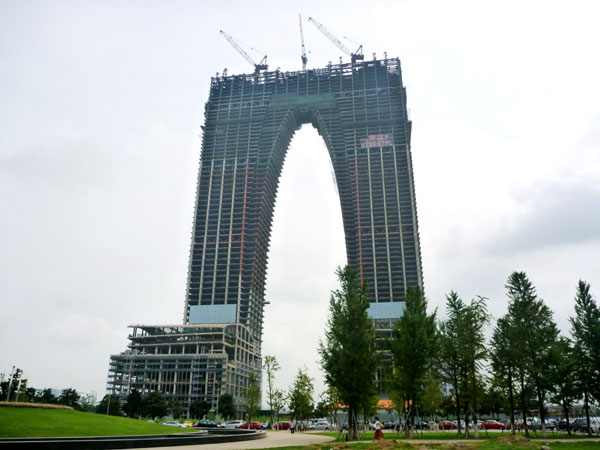Netizens give 'underwear' landmark a kick in the pants
Updated: 2012-09-05 07:55
(China Daily)
|
||||||||
It was meant to be the Arc de Triomphe with an Oriental twist, but many Chinese netizens think it resembles a pair of long underwear.
The developer of a landmark building in Suzhou has come under fire for the unconventional look of the Gate of the Orient designed by British architectural firm RMJM.
 |
|
The Gate of the Orient, a landmark building under construction in Suzhou, has drawn criticism over its appearance as a pair of long underwear. Li Gen / for China Daily |
Suzhou has been known for its idyllic courtyard gardens since ancient times.
Sina Weibo, the country's most popular micro-blogging service, on Tuesday compared the Gate of the Orient in Suzhou to State broadcaster China Central Television's Beijing headquarters - another controversial landmark designed by a foreign firm that locals call dakucha, meaning "big underpants".
The micro-blogging topic on the buildings, entitled "Long Johns versus Big Boxer Shorts", attracted more than half a million posts in just a few hours.
"Why does China look like the playground of foreign designers with laughable architectural ideas?" one blogger commented.
"No matter what kind of pants, it is good construction if it does not fall apart," another blogger wrote. "Otherwise, it will become open-crotch pants."
The 278-meter-tall Gate of the Orient was developed by private firm Suzhou Chianing Real Estate to accommodate offices, hotels, malls and apartments. The eight-year construction project is expected to be completed this year. The cost of the building is about 4.5 billion yuan ($709 million), according to the company's website.
Xu Kang, the company's deputy executive director of sales, defended the design, saying the linked twin tower structure is based on classic garden gates and ancient city gates in China.
He said the aesthetic features of Suzhou's gardens are so well incorporated into the structure that it "inherits the culture of the city to the maximum extent."
Xu said international big-name design firms participated in the bidding process for the project, with RMJM surfacing as the winner.
The Edinburgh-founded firm has been commissioned for a number of projects in Europe, North America, the Middle East and Asia-Pacific region.
Zhou Qi, an architecture professor with Southeast University, said it is not a bad thing for a piece of architecture to spark controversy.
Zhou said he appreciates the design from a professional point of view. "The gate itself resembles the Arc de Triomphe, but it also has elements of Chinese culture."
But the professor also said big projects like this, especially landmarks in city centers, can avoid such controversy if the public is properly consulted in advance.
"Public involvement in decisions on major architecture projects in China remains very low," Zhou said.

 Relief reaches isolated village
Relief reaches isolated village
 Rainfall poses new threats to quake-hit region
Rainfall poses new threats to quake-hit region
 Funerals begin for Boston bombing victims
Funerals begin for Boston bombing victims
 Quake takeaway from China's Air Force
Quake takeaway from China's Air Force
 Obama celebrates young inventors at science fair
Obama celebrates young inventors at science fair
 Earth Day marked around the world
Earth Day marked around the world
 Volunteer team helping students find sense of normalcy
Volunteer team helping students find sense of normalcy
 Ethnic groups quick to join rescue efforts
Ethnic groups quick to join rescue efforts
Most Viewed
Editor's Picks

|

|

|

|

|

|
Today's Top News
Health new priority for quake zone
Xi meets US top military officer
Japan's boats driven out of Diaoyu
China mulls online shopping legislation
Bird flu death toll rises to 22
Putin appoints new ambassador to China
Japanese ships blocked from Diaoyu Islands
Inspired by Guan, more Chinese pick up golf
US Weekly

|

|






